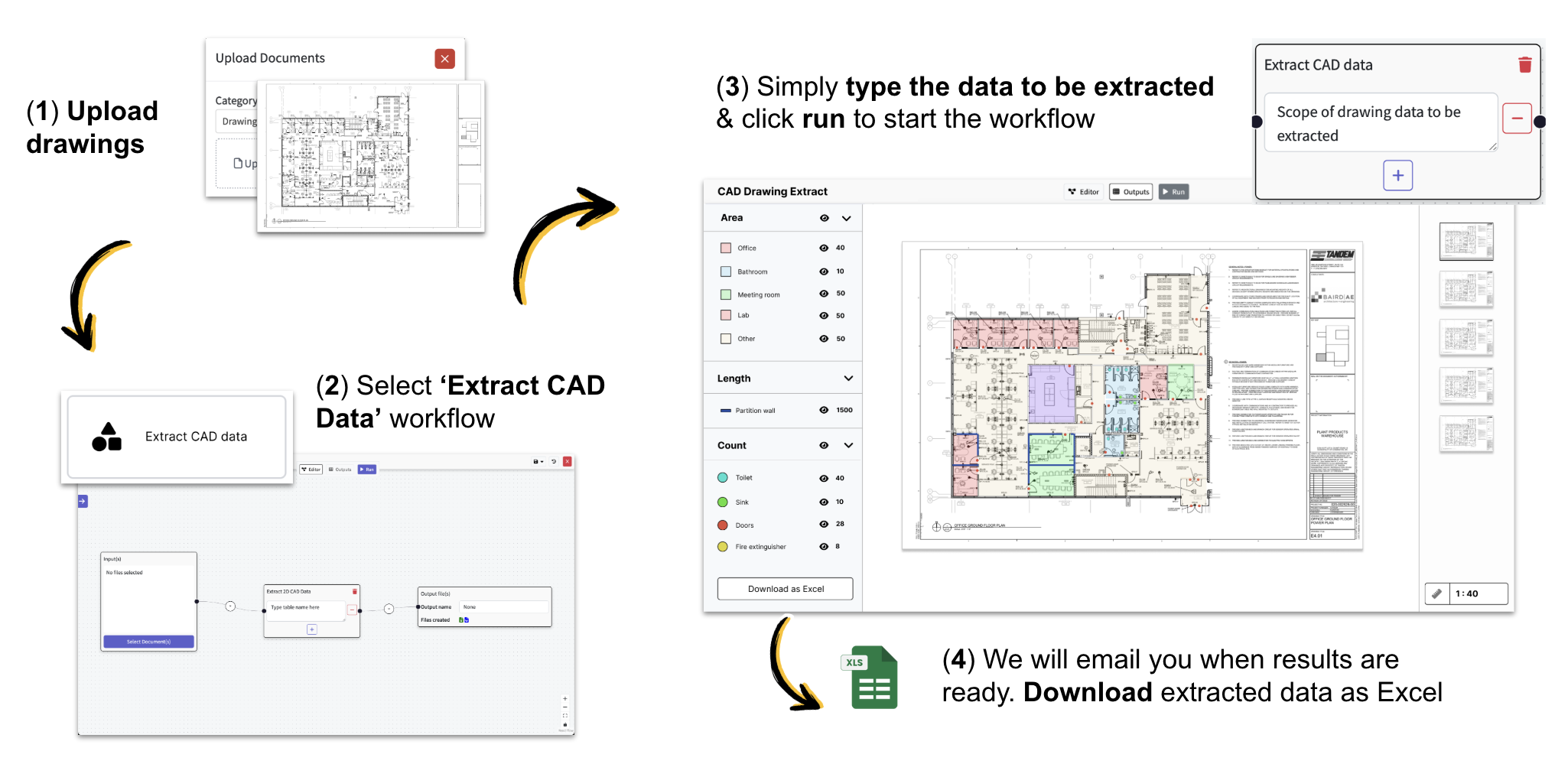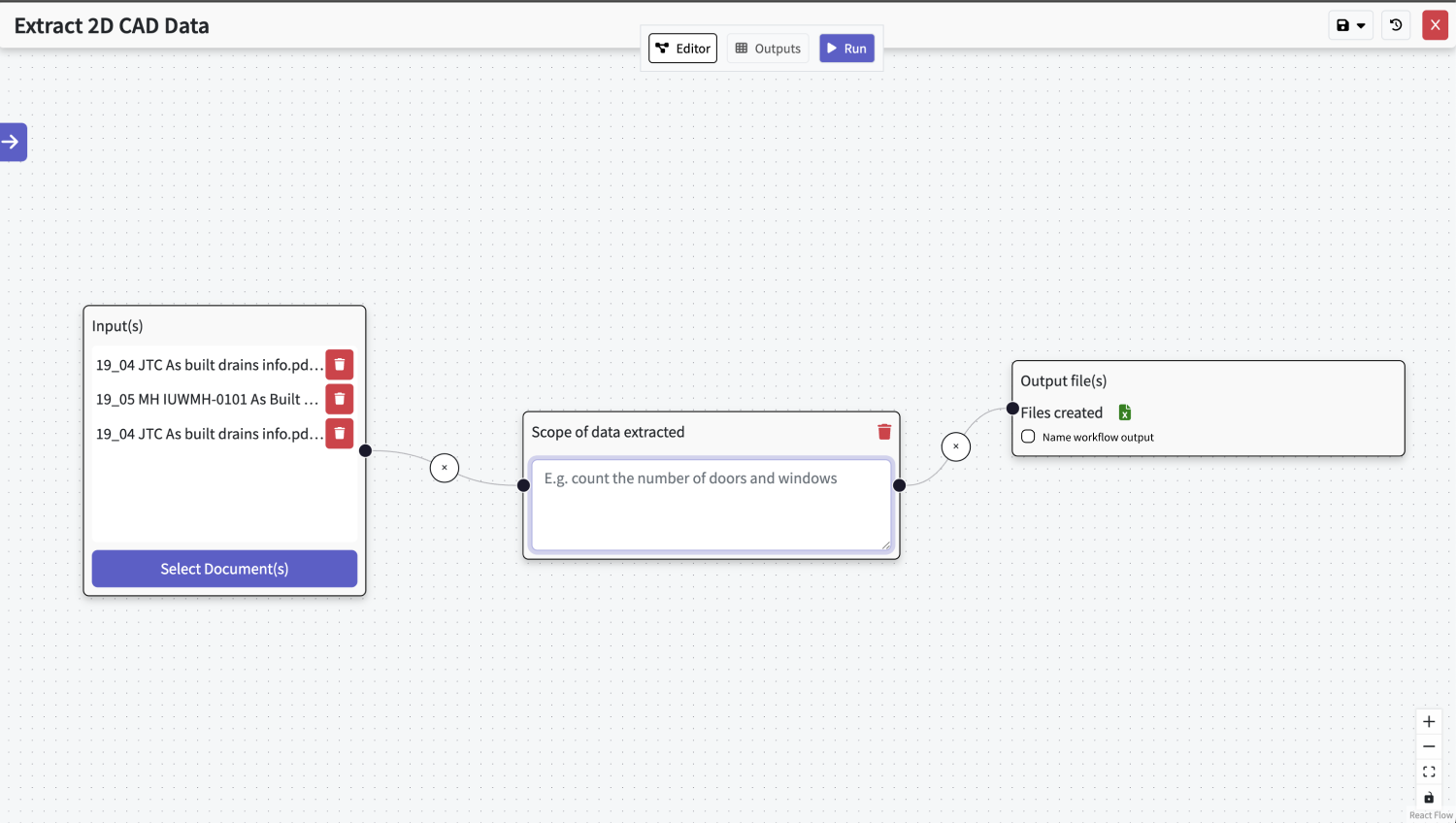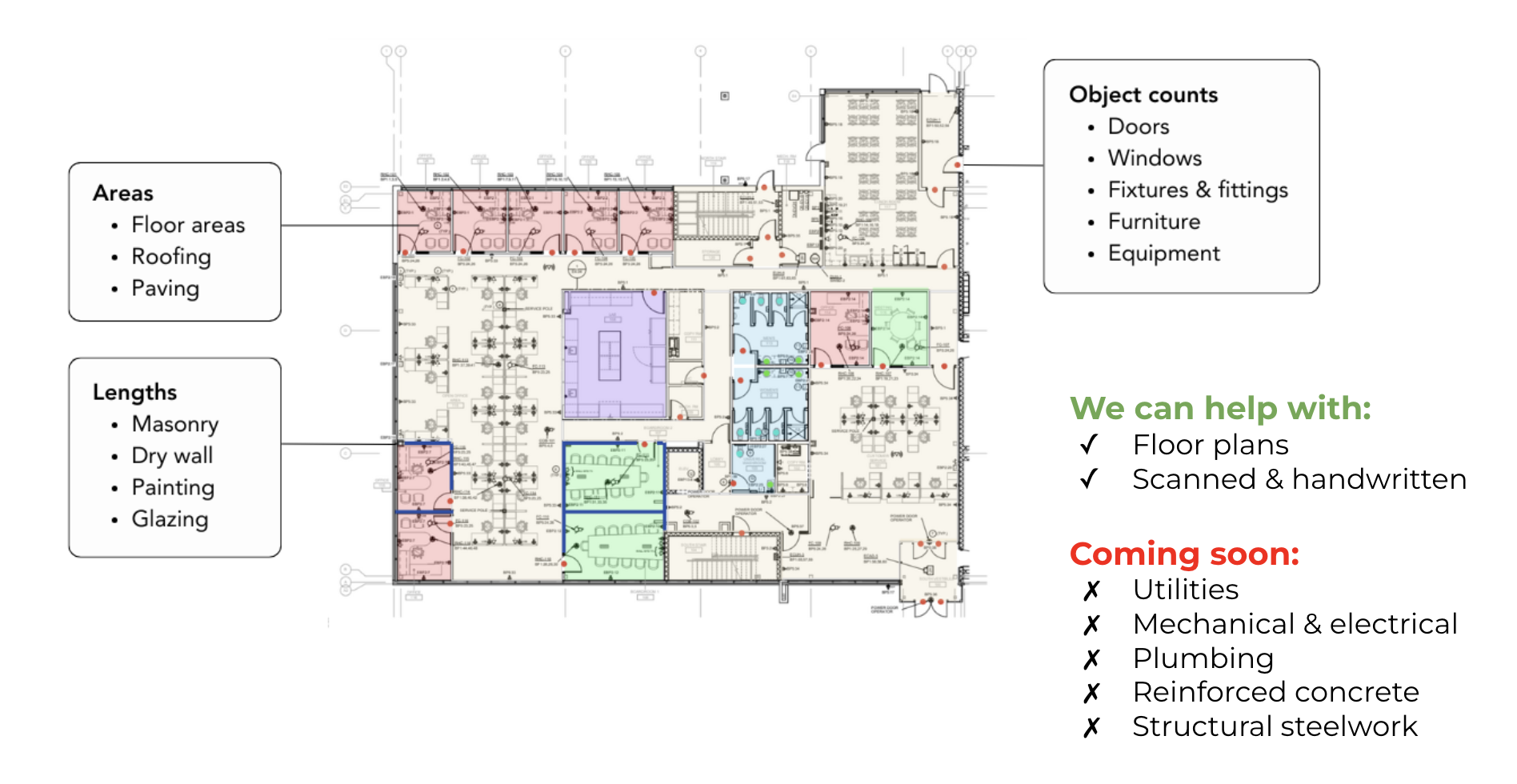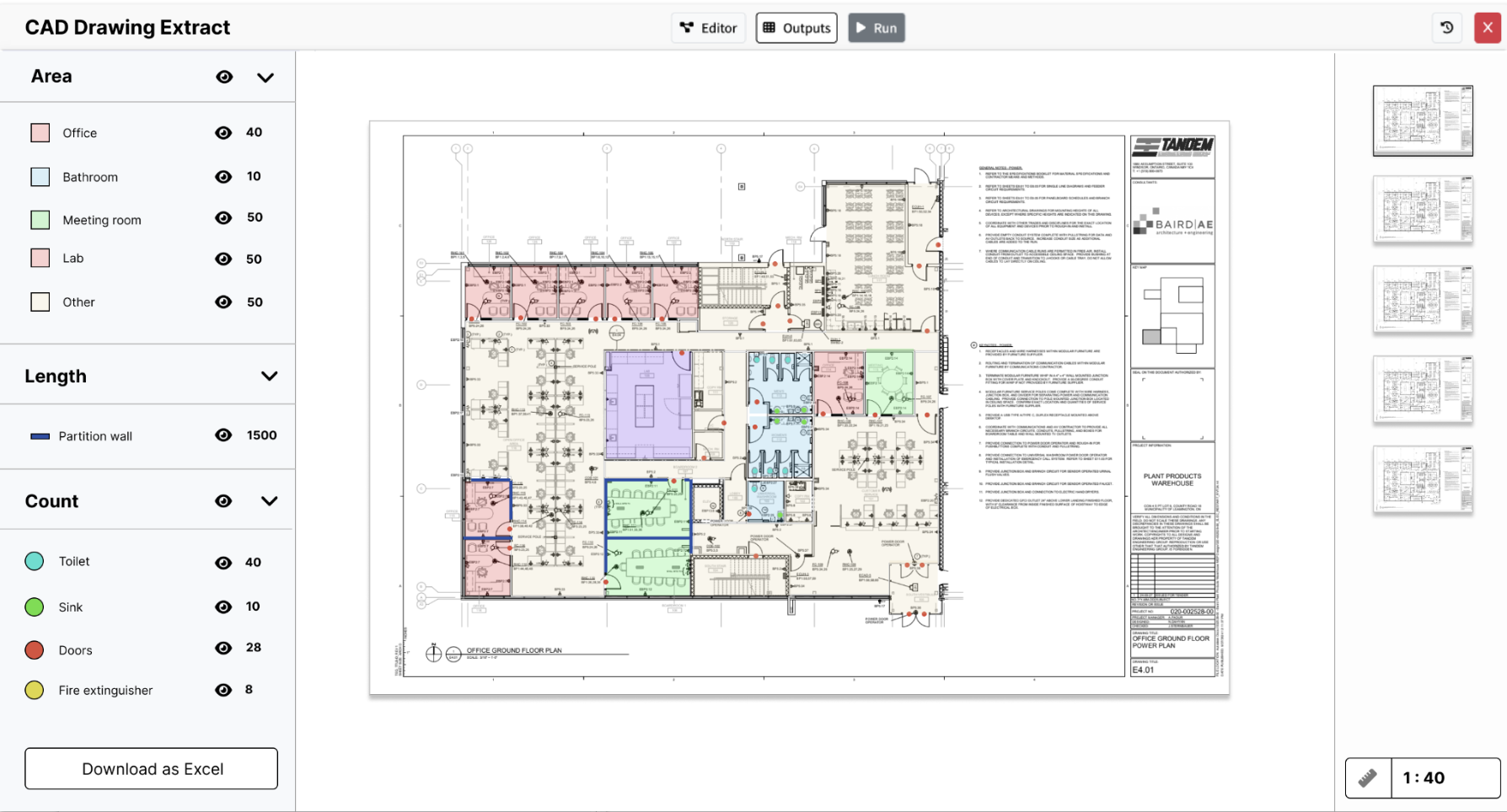How to Use AI for Flooring Quantity Take-Offs

Introduction
Flooring packages live and die by the numbers: total square metres, tile counts, waste factors, trims, and transitions. Manually tracing every room outline, deducting fixed furniture, and multiplying for different finishes can eat up days on large interiors—only to leave margin‑eroding errors. Civils.ai harnesses artificial intelligence (AI) to convert PDFs, scanned drawings, and BIM exports into a structured bill of quantities (BOQ) within minutes, empowering flooring contractors to bid faster and more accurately.
Why Flooring Estimators Need AI
Flooring scopes face unique measurement challenges that traditional take‑off tools struggle to solve. AI removes four critical pain points:
- Irregular Room Shapes – Curved corridors, angled meeting rooms, and inset columns complicate area calculations. Vision models trace complex polygons and calculate true surface area and perimeter.
- Finish Transitions – Projects may switch from tile to carpet or LVT mid‑corridor. AI reads finish codes, splitting room outlines into finish zones for precise quantity splits.
- Pattern & Waste Factors – Herringbone tile or plank patterns drive waste beyond simple area allowances. AI applies pattern‑specific waste multipliers and suggests layout optimisation.
- Revision Chaos – Late furniture plans and partition shifts force re‑take‑offs. AI re‑runs measurements after each revision cloud, refreshing the BOQ in minutes, not hours.
Contractors using AI report generating 30 % more flooring bids per month while lowering material over‑order rates below 3 %.
What Civils.ai Brings to Flooring
Universal Plan & Scan Ingestion
Upload floor plans, reflected ceiling plans (for finish codes), or annotated BIM PDFs—no manual layer sorting. The engine normalises scale and aligns levels so every room is counted.

Conversational Prompting
Type or dictate: “Take off ceramic tile area on ground floor, carpet area on levels 2‑4, perimeter skirting length, and vinyl transition strips.” Natural‑language processing translates your request into measurement rules—no CAD layer mapping.

Room & Finish Recognition
AI detects room boundaries, reads finish tags or hatch patterns, and classifies each area by material (tile, carpet, LVT, epoxy) for material‑specific BOQs.

Automatic BOQ Generation
Surface areas, perimeter trims, tile counts, grout volumes, underlayment and adhesive quantities are compiled into a ready‑to‑price BOQ, exportable to Excel or any major estimating platform.

Human‑in‑Loop Quality Control
Low‑confidence detections—such as ambiguous finish zones—are flagged for review. Estimators can split rooms, adjust waste factors, or override finishes, driving accuracy beyond 95 %.
Insight & Analytics Layer
Dashboards break quantities down by level, finish type, and revision; waste percentages are benchmarked against historical projects, enabling smarter procurement and value engineering.
Step‑by‑Step: Using Civils.ai for a Flooring Take‑Off
- Upload Drawings – Drag‑and‑drop floor plans or CAD PDFs—no file splitting needed.
- Verify Scale & Levels – Confirm drawing scale or let the platform auto‑detect; designate default finish if untagged.
- Describe Your Take‑Off – Example: “Quantify porcelain tile on Level 1, carpet tiles on Levels 2‑3, perimeter skirting length, and adhesive volume.”
- AI Analysis – The model traces rooms, applies finish zones, calculates area and perimeter, and computes material counts in real time.
- Review & Adjust – Use markup tools to split spaces, tweak waste factors, or exclude FF&E areas.
- Export BOQ – One click to Excel, CSV, or direct integration with estimating apps—complete with item codes, waste allowances, and subtotal columns.
Key Benefits for Flooring Contractors & Estimators
- Slash take‑off time by up to 80 % compared with manual tracing.
- Reduce material waste through pattern‑aware optimisation.
- Increase bid accuracy with finish‑specific quantity splits.
- Win more projects by submitting data‑rich, rapid proposals.
Getting Started with Civils.ai
- Book a live demo to see AI flooring take‑offs on your own plans.
- Start a free trial—no credit card required—to experience end‑to‑end flooring BOQ generation.
- Data security & privacy: Drawings are encrypted in transit and deleted on request.
- Dedicated flooring support: Onboarding specialists share pattern optimisation and waste reduction tips.
FAQs
- Can Civils.ai handle patterned tile layouts?
- Yes. The platform applies pattern‑specific waste factors for herringbone, diagonal, or plank layouts and suggests optimal starting points.
- Does the AI account for finish transitions?
- Absolutely. Civils.ai reads finish tags and splits quantities by material, also tallying transition strip lengths.
- How are fixed furniture and kitchen islands deducted?
- The vision engine detects furniture blocks and subtracts their footprint from net flooring area.
- What accuracy can I expect?
- Independent tests show 95 %+ accuracy on flooring areas and perimeter trims, with manual review tools available for fine‑tuning.
Conclusion
Manual flooring take‑offs are slow, error‑prone, and costly. Civils.ai’s AI‑driven platform delivers pattern‑aware quantities in minutes, letting estimators price confidently and protect margins. Ready to upgrade your flooring estimating process? Book a demo or start your free trial with Civils.ai today.